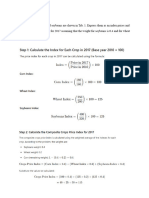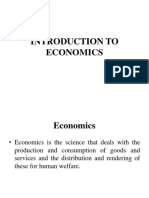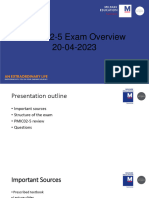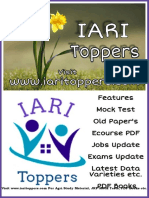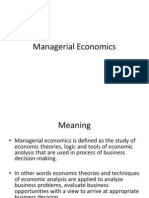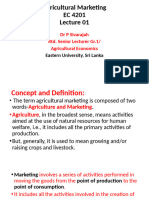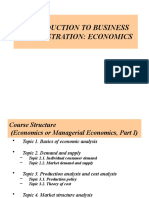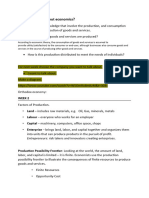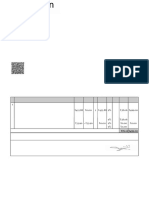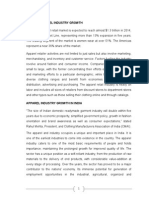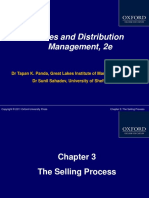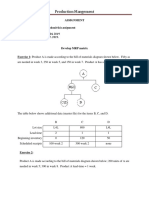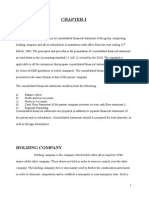0 ratings0% found this document useful (0 votes)
117 viewsModule 1.1 Production Cost and Farm Productivity
Module 1.1 Production Cost and Farm Productivity
Uploaded by
Rheneir MoraThis document provides training materials for a module on production costs and farm productivity. The module objectives are to understand what determines price levels, compute plot-level production costs, explore factors affecting farm productivity, and examine policy implications. Exercises walk through calculating costs of production for individual plots, analyzing cost histograms and supply curves, and estimating yield functions using regression. Key conclusions are that raising productivity through investments in research, extension, and infrastructure can lower costs for farmers and consumers, and public procurement policies should aim to purchase from efficient farmers.
Copyright:
© All Rights Reserved
Available Formats
Download as PPT, PDF, TXT or read online from Scribd
Module 1.1 Production Cost and Farm Productivity
Module 1.1 Production Cost and Farm Productivity
Uploaded by
Rheneir Mora0 ratings0% found this document useful (0 votes)
117 views26 pagesThis document provides training materials for a module on production costs and farm productivity. The module objectives are to understand what determines price levels, compute plot-level production costs, explore factors affecting farm productivity, and examine policy implications. Exercises walk through calculating costs of production for individual plots, analyzing cost histograms and supply curves, and estimating yield functions using regression. Key conclusions are that raising productivity through investments in research, extension, and infrastructure can lower costs for farmers and consumers, and public procurement policies should aim to purchase from efficient farmers.
Original Description:
FARM
Copyright
© © All Rights Reserved
Available Formats
PPT, PDF, TXT or read online from Scribd
Share this document
Did you find this document useful?
Is this content inappropriate?
This document provides training materials for a module on production costs and farm productivity. The module objectives are to understand what determines price levels, compute plot-level production costs, explore factors affecting farm productivity, and examine policy implications. Exercises walk through calculating costs of production for individual plots, analyzing cost histograms and supply curves, and estimating yield functions using regression. Key conclusions are that raising productivity through investments in research, extension, and infrastructure can lower costs for farmers and consumers, and public procurement policies should aim to purchase from efficient farmers.
Copyright:
© All Rights Reserved
Available Formats
Download as PPT, PDF, TXT or read online from Scribd
Download as ppt, pdf, or txt
0 ratings0% found this document useful (0 votes)
117 views26 pagesModule 1.1 Production Cost and Farm Productivity
Module 1.1 Production Cost and Farm Productivity
Uploaded by
Rheneir MoraThis document provides training materials for a module on production costs and farm productivity. The module objectives are to understand what determines price levels, compute plot-level production costs, explore factors affecting farm productivity, and examine policy implications. Exercises walk through calculating costs of production for individual plots, analyzing cost histograms and supply curves, and estimating yield functions using regression. Key conclusions are that raising productivity through investments in research, extension, and infrastructure can lower costs for farmers and consumers, and public procurement policies should aim to purchase from efficient farmers.
Copyright:
© All Rights Reserved
Available Formats
Download as PPT, PDF, TXT or read online from Scribd
Download as ppt, pdf, or txt
You are on page 1of 26
AAMP Training Materials
Module 1.1: Production Cost and Farm Productivity
Steven Haggblade (MSU)
blade@msu.edu
Module Contents
Objectives
Background material
Exercises
Conclusions
Objectives
Understand what determines the price level of a good
Compute plot-level production costs and compare
between farmers
Explore what affects farm productivity using estimate
yield functions
Examine policy implications (for stimulating agricultural
growth & government procurement pricing)
Background Material
Review determinants of price
What factors affect the cost of supplying maize to the
market?
Why does productivity vary across farms?
Determinants of price
Determinants of price (contd.)
What affects the cost of supplying maize to
the market?
Farm-level cost of production
Transport costs (distance to market)
Marketing costs (handling, storage, profit, risk premium)
Why does productivity vary
Among farmers?
Across plots?
Q: Is this a good farmer or
a bad farmer?
Good farmer? Bad farmer?
Good farmer? Bad farmer?
Good farmer? Bad farmer?
Where are the good farmers and bad farmers on
this supply curve?
Exercise 1: Compute Plot-level Cost
Open Production Cost and Price Variability.xls
Read the red NOTES tab to familiarize yourself with the
contents of the workbook
Click on the [data1 plots] tab and explore the data
There are 200 farmers represented
Focus on yield
Why is yield so variable?
Exercise 1: Compute Plot-level Cost contd.
Click on the [ex 1 cost of production] tab
Values in yellow refer to [data1 plot]
Values in green are results
What do you notice?
On average, do farmers have positive revenue?
What are the major costs?
Compare farm productivity between farms
Select a farmer from [data1 plot]
Link the yellow highlighted values to a farm in [data1 plot]
How does this compare to the mean?
Repeat for several different farms
How do they compare to each other?
Exercise 1: Results
Farm productivity varies greatly
Some farmers in the sample receive negative revenue
from maize
Policy should focus on increasing farmer productivity
Raises farmers profits
Lowers consumer costs
Exercise 2: Cost Histogram & Supply Curve
Examine the Cost Histogram in [ex 2 cost groups]
What do you see?
Can you make generalizations about smallholder
production costs based on this histogram?
Exercise 2: Cost Histogram & Supply Curve
Next, examine columns Z, AA & AB in [data4 cost per
ton]
Copy column AB (tot_cost_ton) from [data4 cost per
ton] and paste it into [ex 2 cost per ton]
Sort the column in ascending order (small values to large
values)
Select the entire column and make a line chart
What does this chart show?
Compare with the chart in slide 11 of this presentation
If you were asked to choose a fair maize price based on this
chart, what price would you choose?
Exercise 2: Results
Individual farmers cost of production varies greatly
Setting a price floor based on production costs has
several problems
Who decides whats fair? Where do you draw the line?
Set the price too high government buys large volumes from
inefficient farmers
High price risks pushing out private traders & hurting consumers
Policy that focuses on lowering farmers cost of
production evades these problems
Exercise 3: Estimate Plot-level Yield Function
What are the factors affecting plot-level yield?
Seed Type (high yielding varieties vs. local)
Fertilizer application (kg/ha)
Time of planting (number of days after November 1)
Tillage system (hand hoe, conservation farming basins, plowing,
ripper)
Number of years experience with conservation farming
Plot size
Gender
Yield = a + b Fert + c HYV + d Till +
Yield is a function of Fertilizer, seed type, tillage type etc....
Exercise 3: Regression Equation
Open a new sheet in Excel
Use the Regression Tool to estimate the yield function
See notes in this presentation, as well as the NOTES tab in the
Excel workbook for tips
Examine the coefficients
Which variables have the most impact on maize yield?
Are there any surprises?
How can this information be used in agricultural policy?
Research?
Extension?
Exercise 3: Interpreting Regression Coefficients
Exercise 3: Interpreting Regression Coefficients
Exercise 3: Results
High yielding seed varieties, planting basins, and
fertilizer have a positive impact
Which has the biggest impact?
Which is cost effective? Look at the coefficient on fertilizer is
that a big enough increase in yield to justify the cost?
The planting date variable has a strong negative impact.
Highlights the importance of timeliness in agriculture.
What does this mean for agricultural extension?
Conclusions: empirical
Cost of production differs across farmers and plots
Efficient farmers produce at lowest cost
Conclusions: policy
Raising farm productivity higher farmer profits and
lower costs to consumers
Key public investments for lowering farmers cost of
production
Agricultural research (breeding, agronomy)
Extension (improves agronomic and management practices)
Infrastructure improvements (lowers input cost prices)
If government sets procurement prices
High price large volumes procured. Purchases made from inefficient
farmers
Low price lower volumes procured. Purchases made only
from efficient farmers
References
Chirwa, E. 2007. Sources of Technical Efficiency among
Smallholder Maize Farmers in Southern Malawi. AERC
Research Paper 172. Nairobi: African Economic Research
Consortium.
You might also like
- Production Economics Farm ManagementDocument117 pagesProduction Economics Farm ManagementBP100% (1)
- (K53CLC2) Phan Hoai ThuongDocument40 pages(K53CLC2) Phan Hoai ThuongGiang TrầnNo ratings yet
- SQL Server 2008 R2 Upgrade Technical Reference GuideDocument490 pagesSQL Server 2008 R2 Upgrade Technical Reference GuideshahvijuNo ratings yet
- Farm Management (Agec3101) : Department of Agricultural EconomicsDocument52 pagesFarm Management (Agec3101) : Department of Agricultural EconomicsDagnachew Wale100% (2)
- Lecture 3 Economy of AquacultureDocument24 pagesLecture 3 Economy of Aquaculturesyuhada280304No ratings yet
- Agri Chap 3Document17 pagesAgri Chap 3ኤደን DagneNo ratings yet
- Agricultural Production EconomicsDocument5 pagesAgricultural Production Economicsaneeshmnair535No ratings yet
- Lecture 6 - Agricultural Enterprise Selection and Management-1Document41 pagesLecture 6 - Agricultural Enterprise Selection and Management-1Rogers Soyekwo KingNo ratings yet
- Lecture 6 - Agricultural Enterprise Selection and Management-1Document41 pagesLecture 6 - Agricultural Enterprise Selection and Management-1Rogers Soyekwo KingNo ratings yet
- Farm Management22Document32 pagesFarm Management22Lucky GojeNo ratings yet
- 1 Introduction PDFDocument17 pages1 Introduction PDFAYUSHI MEENANo ratings yet
- Eco 201Document8 pagesEco 201Bangla cartoonNo ratings yet
- Introduction To Business Economics: Session I and 2Document21 pagesIntroduction To Business Economics: Session I and 2Vignesh LakshminarayananNo ratings yet
- Unit 1Document51 pagesUnit 1Anonymous WVEy0mgGKNo ratings yet
- PMIC02-5 Examination Overview 20-04-2023Document34 pagesPMIC02-5 Examination Overview 20-04-2023khahlisochabalalaNo ratings yet
- Agroforestry-Economics MAKRAND GUJARDocument41 pagesAgroforestry-Economics MAKRAND GUJARmddy98No ratings yet
- Improving Profitability : Why Farmers Need Farm Financial ManagementDocument42 pagesImproving Profitability : Why Farmers Need Farm Financial ManagementgildesenganioNo ratings yet
- Econ201 Ch1 OverviewDocument22 pagesEcon201 Ch1 OverviewbeatricekadashiNo ratings yet
- Chapter-4 English Agricultural-MarketDocument29 pagesChapter-4 English Agricultural-MarketThach Nguyen Thi ThienNo ratings yet
- Introduction To Business Administration: Economics (Managerial Economics, Part I)Document28 pagesIntroduction To Business Administration: Economics (Managerial Economics, Part I)Zohaib AhmedNo ratings yet
- Managerial Economics: MBAFT 6103Document36 pagesManagerial Economics: MBAFT 6103rajat9goelNo ratings yet
- Managerial Economics & Business StrategyDocument12 pagesManagerial Economics & Business StrategyInanda Shinta AnugrahaniNo ratings yet
- 37Document114 pages37NitinNo ratings yet
- Quantitative Tools for Agricultural Policy AnalysisDocument42 pagesQuantitative Tools for Agricultural Policy Analysisncplagumbay00130No ratings yet
- Chapter 11 - Sheep and Goat Economics of Production and MarkeDocument28 pagesChapter 11 - Sheep and Goat Economics of Production and MarkegavinilaaNo ratings yet
- Essc 3.11.1 CH-1Document12 pagesEssc 3.11.1 CH-1Shaik MuneerNo ratings yet
- Mangerial EconomicsDocument353 pagesMangerial Economicsrajan2778No ratings yet
- Managerial Economics Unit-2Document32 pagesManagerial Economics Unit-2Sharma GsrNo ratings yet
- Agricultural Production Economics (3)Document271 pagesAgricultural Production Economics (3)Takele HonjaNo ratings yet
- Evolving Comparative Advantage and The Impact of Climate Change in Agricultural Markets: Evidence From 1.7 Million Fields Around The WorldDocument28 pagesEvolving Comparative Advantage and The Impact of Climate Change in Agricultural Markets: Evidence From 1.7 Million Fields Around The WorldTiago MatosNo ratings yet
- Lecture 01- Introdn to Agric MktgDocument23 pagesLecture 01- Introdn to Agric MktgJanath AnthonyNo ratings yet
- OVERVIEW OF AGRIBUSINESS MANAGEMENT1Document29 pagesOVERVIEW OF AGRIBUSINESS MANAGEMENT1Samuel OluwatosinNo ratings yet
- ECONOMICS (Econ.) : Def. A Social Science That Deals With Man's Problem ofDocument33 pagesECONOMICS (Econ.) : Def. A Social Science That Deals With Man's Problem ofAbbon Lacson Loong-MananesNo ratings yet
- Farm Management ABM 351 (Autosaved) - 1Document94 pagesFarm Management ABM 351 (Autosaved) - 1DelloNo ratings yet
- Introduction To Business Administration EconomicsDocument26 pagesIntroduction To Business Administration EconomicsTrueMastaNo ratings yet
- Economics NotesDocument8 pagesEconomics Notes19281565No ratings yet
- Economic Issues and Concepts: (Chapter One) Principles of Macroeconomics Econ1202.2BDocument27 pagesEconomic Issues and Concepts: (Chapter One) Principles of Macroeconomics Econ1202.2BNayem ImtiazNo ratings yet
- Week 1 Lecture Slides S1 2024Document8 pagesWeek 1 Lecture Slides S1 2024joehe2625No ratings yet
- tot3_1Document28 pagestot3_1username79780No ratings yet
- Study Material Course No.: Ag Econ 122 (Production Economics and Farm Management) Credit Hours: 1 + 1 2 Semester:IIDocument71 pagesStudy Material Course No.: Ag Econ 122 (Production Economics and Farm Management) Credit Hours: 1 + 1 2 Semester:IIDevrshi UpadhayayNo ratings yet
- Study Material Course No.: Ag Econ 122 (Production Economics and Farm Management) Credit Hours: 1 + 1 2 Semester:IIDocument71 pagesStudy Material Course No.: Ag Econ 122 (Production Economics and Farm Management) Credit Hours: 1 + 1 2 Semester:IIDhungana SuryamaniNo ratings yet
- 2022F Microeconomics Ch1Document25 pages2022F Microeconomics Ch1Jyunde WuNo ratings yet
- Marketing Cost Etc. ConceptsDocument27 pagesMarketing Cost Etc. ConceptsMOHIT CHAUDHARYNo ratings yet
- Core Requirements Agriculture DevelopmentDocument8 pagesCore Requirements Agriculture DevelopmentMonique TabuacNo ratings yet
- The Agribusiness SystemDocument33 pagesThe Agribusiness SystemArti ArhaNo ratings yet
- EDPI Paper 6 - ManishDocument11 pagesEDPI Paper 6 - ManishrsunderyNo ratings yet
- Ba7103 Economic Analysis For Business: Unit I - Introduction - Themes of EconomicsDocument24 pagesBa7103 Economic Analysis For Business: Unit I - Introduction - Themes of EconomicsSaravanan ShanmugamNo ratings yet
- Macroeconomics FlashcardsDocument15 pagesMacroeconomics FlashcardsDineshkumar RajukalaiselviNo ratings yet
- NotesDocument41 pagesNotesdonatusaa001No ratings yet
- Lecture 4 - Agri Support PolicyDocument12 pagesLecture 4 - Agri Support PolicySpare Email AccountNo ratings yet
- Value Chains For Staples Compared To Other Crops - FinalDocument18 pagesValue Chains For Staples Compared To Other Crops - Finalwebermi6513No ratings yet
- Microeconomics Course: BY Emery Emerimana MBA-Project Management and Finance Email: Tel: 71 578 069/75 658 470Document103 pagesMicroeconomics Course: BY Emery Emerimana MBA-Project Management and Finance Email: Tel: 71 578 069/75 658 470dan dylan terimbereNo ratings yet
- Farm ManagementDocument77 pagesFarm Managementlemmademe204No ratings yet
- Managerial Economics - NotesDocument35 pagesManagerial Economics - NotesShivaprasad NageshNo ratings yet
- OR1Document135 pagesOR1Shresth BhatiaNo ratings yet
- Farm Management 2Document241 pagesFarm Management 2Prime Rieta100% (1)
- The Agribusiness SystemDocument33 pagesThe Agribusiness Systemabadi girsang100% (1)
- 2.2 SupplyDocument18 pages2.2 SupplyGrace GeNo ratings yet
- Farm ManagementDocument24 pagesFarm Managementalexjacky718No ratings yet
- Smart Portal For Good Pricing in AgricultureDocument27 pagesSmart Portal For Good Pricing in AgriculturekeerthanaNo ratings yet
- Form45 3Document2 pagesForm45 3Rheneir MoraNo ratings yet
- RDO No. 47 - East MakatiDocument83 pagesRDO No. 47 - East MakatiRheneir MoraNo ratings yet
- Cit U Bsa ProspectusDocument4 pagesCit U Bsa ProspectusRheneir MoraNo ratings yet
- Cit U Bsma ProspectusDocument4 pagesCit U Bsma ProspectusRheneir MoraNo ratings yet
- October 2020 Tax AlertDocument5 pagesOctober 2020 Tax AlertRheneir MoraNo ratings yet
- Tax Alert Special Issue March 31, 2020 (Final)Document15 pagesTax Alert Special Issue March 31, 2020 (Final)Rheneir MoraNo ratings yet
- 49 Insights June 2022V2Document24 pages49 Insights June 2022V2Rheneir MoraNo ratings yet
- Tax Alert September 2020 Final v2Document6 pagesTax Alert September 2020 Final v2Rheneir MoraNo ratings yet
- Tax Alert Regular Issue (March 2020)Document19 pagesTax Alert Regular Issue (March 2020)Rheneir MoraNo ratings yet
- Tax Alert (December 2020)Document10 pagesTax Alert (December 2020)Rheneir MoraNo ratings yet
- Tax Alert (June 2020)Document7 pagesTax Alert (June 2020)Rheneir MoraNo ratings yet
- 2020soar 2019 Ifiar Survey ReportDocument28 pages2020soar 2019 Ifiar Survey ReportRheneir MoraNo ratings yet
- Tax Alert (April 2020) FinalDocument30 pagesTax Alert (April 2020) FinalRheneir MoraNo ratings yet
- KAMMP Seminar - AccountingDocument37 pagesKAMMP Seminar - AccountingRheneir MoraNo ratings yet
- Obligations and Contracts: Atty. Rheneir P. Mora, CPADocument55 pagesObligations and Contracts: Atty. Rheneir P. Mora, CPARheneir MoraNo ratings yet
- KAMMP SeminarDocument2 pagesKAMMP SeminarRheneir MoraNo ratings yet
- Tienganh_Phan4_Cau11_4Document2 pagesTienganh_Phan4_Cau11_4Đoàn Mai PhươngNo ratings yet
- InvoiceDocument1 pageInvoicernikhil0100No ratings yet
- 06 Reaction Paper - The Entrepreneur's Business PlanDocument2 pages06 Reaction Paper - The Entrepreneur's Business PlanKristoffer PangueNo ratings yet
- Tax 2 SyllabusDocument10 pagesTax 2 SyllabusJunnieson BonielNo ratings yet
- CV9Document3 pagesCV9Ali Zafrullah BinudinNo ratings yet
- Yahoo VS Alibaba CASE 1Document4 pagesYahoo VS Alibaba CASE 1Kulašin Nedim0% (1)
- Eng6 ResearchDocument7 pagesEng6 ResearchCamille EsporlasNo ratings yet
- 3 Screen Report May08Document4 pages3 Screen Report May08Billy ShippNo ratings yet
- Cba 1104 2023Document5 pagesCba 1104 2023Lawrence ZviksNo ratings yet
- ENT Paper 3 Question ApproachDocument7 pagesENT Paper 3 Question Approachmirembebelinda10No ratings yet
- Discovering: Business ArchitectureDocument72 pagesDiscovering: Business ArchitectureDario CedanoNo ratings yet
- Law 3212 Cases Review Final CompiledDocument9 pagesLaw 3212 Cases Review Final CompiledMohamad WafiyNo ratings yet
- Global Apparel IndustryDocument48 pagesGlobal Apparel IndustryHaЯsh السوداوي Upadhyay السوداويNo ratings yet
- NetSoft Solutions Profile PDFDocument20 pagesNetSoft Solutions Profile PDFMuhammad SalmanNo ratings yet
- Strategic and HRM Aspects of Kaizen: A Case Study: Hedley MallochDocument15 pagesStrategic and HRM Aspects of Kaizen: A Case Study: Hedley MallochLeo RuilovaNo ratings yet
- C13 Assignment 4Document2 pagesC13 Assignment 4MalykaNo ratings yet
- 0520 Commerce 2 Gce Ol 2021Document2 pages0520 Commerce 2 Gce Ol 2021franckzoa12No ratings yet
- Determinant of Dividend Policy in Indian Cement IndustryDocument12 pagesDeterminant of Dividend Policy in Indian Cement IndustryRajpal MalhotraNo ratings yet
- Kieso 17e ch16 EPS PracticeDocument7 pagesKieso 17e ch16 EPS PracticeHasanurRaselNo ratings yet
- Business PlanDocument18 pagesBusiness PlanArnio SaludarioNo ratings yet
- Jboss Admin Interview QuestionsDocument107 pagesJboss Admin Interview QuestionsPriya DaggubatiNo ratings yet
- Taj HotelsDocument9 pagesTaj HotelsNeha KapurNo ratings yet
- CPM PERT Lecture Notes - 2 Visit Us at Management - UmakantDocument12 pagesCPM PERT Lecture Notes - 2 Visit Us at Management - Umakantwelcome2jungleNo ratings yet
- 412 33 Powerpoint Slides 3 Selling Process Chap 3Document10 pages412 33 Powerpoint Slides 3 Selling Process Chap 3Juber Farediwala0% (1)
- List of Practicing Firms Having Satisfactory QCR Rating (As On March 1, 2021)Document2 pagesList of Practicing Firms Having Satisfactory QCR Rating (As On March 1, 2021)Mohammad Ehsan IrfanNo ratings yet
- Assignment MRPDocument5 pagesAssignment MRPlapunta2201No ratings yet
- Hazard Identification, Risk Assessment & Risk Control (Hirarc)Document26 pagesHazard Identification, Risk Assessment & Risk Control (Hirarc)Satrio Rekso100% (1)
- MCOM Sem 1 FA Project On Consolidated Financial StatementDocument27 pagesMCOM Sem 1 FA Project On Consolidated Financial StatementAnand Singh100% (5)












